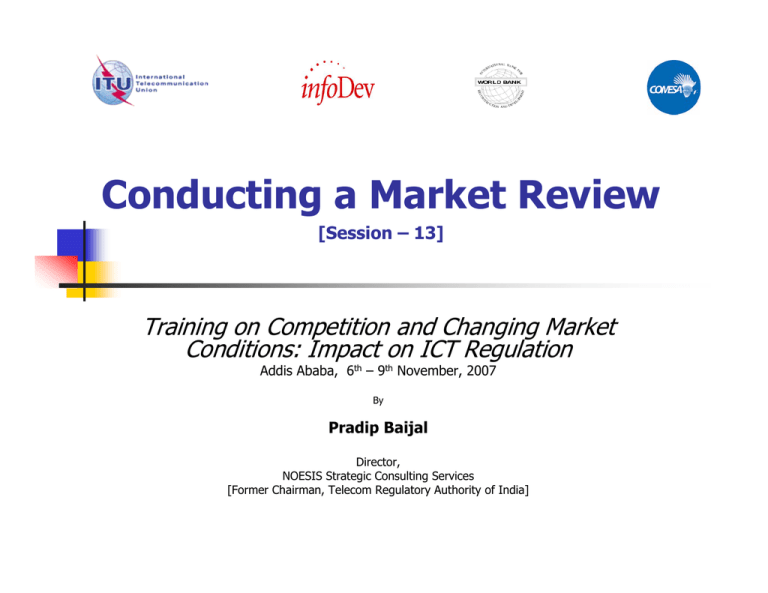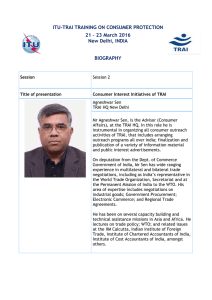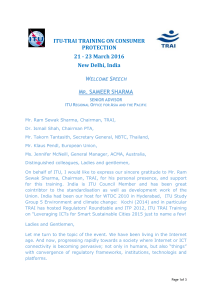Conducting a Market Review Training on Competition and Changing Market
advertisement

Conducting a Market Review [Session – 13] Training on Competition and Changing Market Conditions: Impact on ICT Regulation Addis Ababa, 6th – 9th November, 2007 By Pradip Baijal Director, NOESIS Strategic Consulting Services [Former Chairman, Telecom Regulatory Authority of India] Introduction Competition principles are unexceptionable In TRAI we took advise from the best Consultants / Economists / Advisers to define these principles We also had people working in TRAI, who had earlier worked in WTO / GATT Yet the minefield is – what principle to adopt at what time And to decided on what is the best and what is possible – at different stages of the telecom market At each stage the Regulatory has to conduct a market review to decide on the way forward This is the most difficult exercise which I will try to explain in this session. Initial Phases of TRAI - 1997 Government was policy maker, licensor and incumbent service provider. This was reflected in a number of clauses in the licenses, specially for mobile which favoured the incumbent operator e.g. Mobile operator could not directly connect. TRAI was a Regulator as well as Adjudicator on disputes. Differences of opinion between TRAI and Government regarding the powers that TRAI try to exercise. Government saw this as an attempt to assume more powers than those granted under the Act. High Court also ruled against the Regulator. The disputes with the first Regulator led to premature termination of TRAI’s term from 5 to 3 years. TRAI’s Response TRAI tried to level the playing field through its tariff and interconnection policy and stopped competition from Government incumbent by not allowing it to become a mobile service. Thus, not enhancing a competitive framework was a policy about turn but in the interest of level playing field for the challenger who was initially not even allowed for interconnection. Later reduction in interconnect charges brought in huge disputes Since duopoly was prescribed by the Government, there was insufficient competition. Existing players also tried not to allow more operators. National Telecom Policy ‘99 Unreasonable high entry fee was replaced by reducing revenue share. In the bargain duopoly was replaced by unlimited competition. Two more players introduced at this stage, one of them being the incumbent. Yet, competition was insufficient as CDMA technology was only allowed fixed telephony or later limited roaming. One operator converted limited roaming to unlimited roaming with the help of technology, yet license conditions were not breached. Unlimited litigation. Sector in losses. High tariffs. Low growth. Other 1999 initiatives In 1999 tariff revision brought major changes in the prevailing regime. Major decline in price of leased circuits thus increasing competition TRAI allowed operators to give alternative tariff packages to attract customers. This increased competition and reduced tariffs. Yet, there was a strong view that since the incumbent was providing services to rural area and to the poor at low tariff, its hand were tied. Therefore, a huge concessions to incumbent, normally much more than its losses on these services. Non level playing field Also, huge cross subsidies and Government subsidies. Cross subsidies to the extent of 30% of sectoral review This made sector uncompetitive and without a level playing field To prevent vertical price squeeze etc., TRAI introduced accounting separation in 2002 and very close monitoring of tariffs by the Regulator. In the initial years, regulator was taken to the appellate body mostly by the incumbent who was strong Later, when the newcomers became more established players, this pattern changed. Post 1999 initiatives (contd.) TRAI allowed for greater competition through price flexibility and curbed anti-competitive activity through price monitoring It also prepared the grounds for sustainable competition by doing tariffs rebalancing and access deficit charge regulation Tariff re-balancing and ADC was declared for a three year period – later extended to five years. ADC policy reviewed every year and would become zero in 2008. However, during this period whenever incumbent took TRAI before TDSAT, the incumbent was represented by the Solicitor General, whereas TRAI was represented by a private lawyer. It appeared that the incumbent was State while TRAI was a private body. Regulator recognized that competition for the incumbent would come from the mobile services, and later from the internet services. Hence, tariff re-balancing both for fixed and mobile services. Post 2003 initiatives Regulator introduced calling party pays. Termination charges were reduced to the minimum. Carriage charges also reduced after domestic leased line charge reduction Origination charges left to operators. Since call tariff is decided at this point. Thus competition more aggressive. ADC reduced from 30% to 10% of sectoral revenue in 2003. The Regulation prescribed that it would be zero in 2008. Firstly, mobile tariffs were kept low by regulation to mimic market competition. In late 2003, competition regulation was adopted, removing all tariff restrictions. Regulation also allowed to be technology agnostic. Thus, fifth and sixth operator introduced. Revenue share reduced further. Thus, tariffs fell hugely and there was explosive growth. Restrictions on price of handsets also removed. Further initiatives To encourage the use of mobile and stop the extremely high roaming charges, TRAI took the unprecedented step of capping these charges in 2002. These were later reduced by Government in 2005. Regulator also specified low value pre-paid cards. Regulator also recommended that the number of operators be increased in long distance segment and for mobile services, wherever spectrum was available. It also recommended that the limited mobility services be continued using wireless in local loop, to increase competition on fixed service. All these policy changes were possible because TRAI monitored and collected detailed cost data with an accounting separation. All changes were made after wide and transparent consultations and the publication of the data leading to a very strong case in favour of the Regulator. Interconnection charges continuously reduced with the help of available data. Monitoring by TRAI Despite the policy of tariff forbearance introduced in 2003, TRAI followed the market developments and did not allow implicit collusive price increase It used cost-based data to discourage collusive practices One example of this is the time when some mobile operators increased the charges for SMS. They were got reduced with the help of collected data. TRAI recognizes that a key to creating a level playing was to have an interconnection policy which promoted competition. However, the area of interconnection was more difficult to regulate in comparison to tariffs, for a lack of legal clarity in the Act and consequent litigation. In one case, TDSAT ruled for a short time, that interconnections were outside jurisdiction of TRAI. By definition all problems of interconnection are disputes among two parties. At one stage, TDSAT ruled that TRAI could not enforce prescribed tariffs. All such cases were got reversed in appeals and review. Limits to growth After about 65 years of telephony in India it was realized that telecom coverage was only in urban areas. This could not be allowed to continue and regulatory intervention was necessary. Rural and Urban teledensity gap is widening Rural Total Urban 25 21.3 20 Teledensity 14.3 15 12.2 10.4 8.2 10 5.8 4.8 4 5 0 1.3 0.3 1.6 0.3 1.9 0.4 7.04 6.9 2.3 0.5 2.9 0.7 3.6 0.9 4.3 1.2 5.1 1.5 1.7 1996 1997 1998 1999 2000 2001 2002 2003 2004 Rural area expansions TRAI recognized that telecom services could not expand in rural areas with fixed line alone and with the help of USO funds. Earlier the Government had not allowed mobile to be covered under USO because such phones could be taken to urban areas. To encourage rural growth, TRAI recommended in 2004 that the mobile infrastructure be subsidized in rural areas but on a competitive platform. This was accepted by the Government in 2007. The present huge Indian telecom growth has been catalyzed by this scheme. After all, 70% of the population lives in rural areas. Rural expansion is now taking place at a fraction of the earlier USO costs and at a very fast pace. Assessing Rural area market TRAI assessed the rural area market by reviewing the following figures. No. of households with key durables (in million) Urban + semi-urban Rural 43% 24.84 59.34 44% 32% 23.76 44.16 32% 64% 19% 34.56 26.22 12% 25% 7% 13.5 9.66 All India Urban + semi-urban Rural Total Households (Millions) 192 54 138 1 Bicycle 44% 46% 2 Radios 35% 3 Television 4 Two wheelers (Scooters & Motorcycles) S. No. The future A combination of a cost based, asymmetric and later competition and level playing field regulation has exploded the Indian telecom market. The teledensity is presently 25% and all experts believe that we will exceed 50% by 2010. Even today teledensity in large metros like Mumbai and Delhi is around 90%, like in cities of the developed world. We will shortly catch up with the rural disadvantage. Thank you

